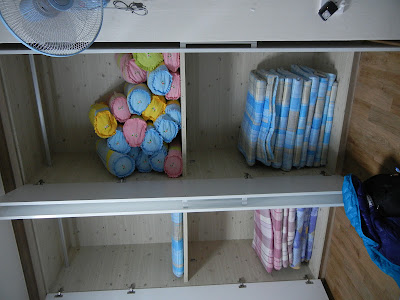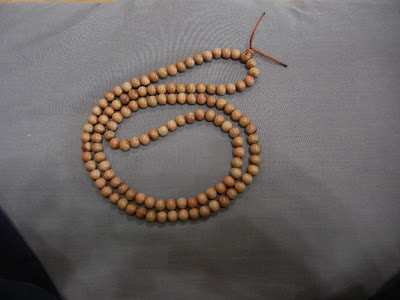I need to go back a few years to explain further.
 |
| View of the temple lanterns at 3:30am |
Eat. Pray. Love. If you have seen the movie, I'm sorry. It was terrible. Elizabeth Gilbert should have compensation for her losses and misrepresentations. The book however, was, I thought, good. I am not book club material, I just like to read but reading this book felt like it was me speaking. Amy and I have been talking about and discussing this book for years for various reasons and Lee Ann fits right in with that.
Part of the book takes place in Italy, part in Bali and part in India at an Ashram. Hence our Temple Stay. Elizabeth Gilbert writes about her experience into the Yogi and Buddhist ideals. This isn't exactly what I believe but I liked what and how she wrote about it and wanted to learn more. I cannot speak for Amy and Lee Ann but I believe we all feel a similar connection.
The first part of the weekend: Korean Beef. Scrumptious. We posed with a few aujummas and then boarded the bus to the temple.
Temple stays offer a unique opportunity to experience a tiny taste of the Buddhist monks’ life. It was a 2 day temple stay at the 1400 year old Buddhist temple, Bubheungsa, on Mt. Sajasan. The Jogye Order has about 3,000 temples around Korea (about 24% of South Koreans are Buddhists).
Bubheungsa is one of the relic temples. Instead of having a Buddha image, it actually houses some of the ashes of Sakyamuni Buddha. Like many of Jogye’s temples, Bubheungsa is located in a pristine, natural mountain environment and the temple buildings and compound are truly beautiful. The Temple Stay program affords participants the chance to live in such an environment, sample ordained lifestyle, and experience the mental training and cultural atmosphere of Korea’s ancient Buddhist tradition for a weekend.
After receiving our new temple garb and stashing our street clothes into lockers, the entire WinK (When In Korea) group met for a brief introduction to the temple.
Buddhism is the name for the teachings of Sakyamuni Buddha--it does not rely on an absolute god or on the revelation given by a god. Sakyamuni Buddha criticized other philosophers’ doctrines which ignored humanity’s freedom of thought. He said that the world is the result of causes and conditions; the most important thing is the intention of human beings. Buddhism is based on the will and rationality of human beings and emphasizes rational practices (Koreabuddhism.net).
A philosophy based on the idea of the rationality of human thought? No wonder it’s slowly disappearing in Korea.
 |
| walking meditation |
 |
| SLOW walking here to meditate |
After supper, it was time for the evening service. The highlight of the service was the bell ringing and the resonant sounds of the drum, gong, and wooden fish.
 |
| Rice, seaweed soup (good), boiled radish kimchi, sprouts and kimchi |
 |
| Lee Ann |
Everyone on the temple stay got to take their turn ringing the bell.
A tea drinking ceremony and dialogue with Sunim on dreams followed. The monk explained the importance of dreams in Buddhism--concrete achievable dreams and goals.
I was quite surprised when we did the survey around the room asking what people’s dreams were and why they had come to the temple stay. Many people said that they had come to the temple stay to get a slice of Buddhist life or to get away from the city and smog (it is fair to mention here that 90% of the participants were from Seoul). A substantial portion of the participants hoped to learn a great deal about Buddhism and/or spend a lot of time meditating--a temple stay is NOT the venue for that. You get little tastes but if you want to learn anything substantial you’re going to need something a little less touristy. We made our dream pouch then hiked the mountain to our lodging.
 |
| did you think I'd put my dream on this? |
 |
| Lee Ann |
 |
| actually comfortable |
 |
| who knows how old this wood is |
 |
| beautiful |
We get up again and make our way back to the main room for our official "monk meal." Delicious! The food on this trip was delightful and very good. Vegetarian, yes, but tasty and filling. This lasted about an hour or so because we watched a small video describing what, why and how to do this properly then we ate.
 |
| rice, cabbage soup (excellent), potatoes, tofu, green veggies, yellow radish the smallest bowl on top right is your cleaning bowl with a little water in it |
 |
| Lee Ann got to help! |
 |
| using the water in the smaller bowl to hand wash the others |
Eating can be an incredibly complex ritual for the monks. You’re supposed to sit in the lotus position for the entire meal, although we were given a pass on that. There’s a certain order in which you unstack your bowls, a certain hands that you accept and serve rice with, even specific shapes you are supposed to create when serving the rice. But at the end of the meal, you are supposed to take a piece of pickled radish or kimchi and a little bit of water and use that to clean your bowl, eating the radish and drinking the water when you are done. It’s exceptionally important to the monks that you eat absolutely all of your food and that nothing is wasted. There’s even a little legend about a monster who has a very skinny throat. If even a single grain of rice is left behind, he will choke on it and die (and that’s a bad thing). There was some grumbling and decrees of grossness (but it’s not as if you hadn’t just eaten almost everything before you swished some water around anyway) but everyone complied.
The cruelest thing during the entire weekend was after this meal. Morning meditation. 15 minutes of meditating which is fabulous and entertaining in your own head. The cruel part is they turned the lights off. Really? Aside from that it was great. I enjoy being still and thinking. I need it to maintain my center and sanity. If you have ever read EPL (Eat, Pray, Love) you will definitely be familiar with how Elizabeth Gilbert felt when she began meditating. Talking in your head and trying not to think of anything in particular goes in the opposite direction. After a few minutes I was able to settle but it was a good idea to finish after 15 minutes.
Nap time was after meditation and we all slept on the wonderfully cushy and soft cushions and didn't wake up until 2 hours later. Bliss.
 |
| Lights on and wake up! Right after our two hour nap |
Now for the coolest and most demanding part of the entire Temple Stay. Our lantern making and our making of the beads. 108 beads. 108 bows. Except I should have counted my beads before I began and I had 119 beads so 119 bows. Then I bowed without putting a bead on so it was really 120. It was amazing and fun. Yes, fun. The three of us decided to not cheat as much as possible this weekend and we didn't. Most of the other people put 5 or 10 beads on at a time and were finished much earlier than we were but we enjoyed doing each one. I would do it again. The bows are called prostrations.
A prostration involves standing up with hands in a prayer position, feet together. You go down onto your knees (there’s a pillow) with your hands still in position and cross your feet. Then place your forehead on the pillow in front of you with your hands beside your head. Raise your hands slightly to your ears and then put them back on the ground. During this whole process, you should be as close to the ground as possible--no butt sticking up in the air, please. Sit back onto your feet and knees again and put your hands back into the prayer position. Uncross your feet and stand up (keeping the hands in prayer position). Now repeat 108 times or in my case 120.
 |
| Lee Ann |
 |
| Lee Ann's, mine, Amy's |
After our prostrations and necklace making we took our dream pouches up the mountain again and performed a tiny ritual of a chanting song and then hanging up our dream pouches. After the dream pouch ceremony, it was time for us to turn in our comfy Buddhist clothes and prepare to return the chaos of Korea.
 |
| lying down Buddha: right to left: head, lips, folded hands |
 |
| sunshine view of our 3:30am trek up the mountain |
I highly recommend the temple stay to anyone interested about Buddhism or looking to experience a more traditional lifestyle in Korea. The two day experience is not overwhelming and should allow you to dip your toes in.
After we left our temple we headed to our next part of the weekend: pottery making. This was not a Demi Moore and Patrick Swayze moment but a here's a lump of clay have fun and make a bowl, vase or cup. Not as much writing on this part because the main focus was the temple stay.
 |
| Amy's Daisy |
 |
| my Makgeolli bowl the guy had to fix it so this is what it ended up being |
 |
| prayer mound these are all over Korea. You put a stone on it and make a wish or pray The idea is if it doesn't fall off your prayer/wish will be granted |
Enjoy and if you have any questions Google, "South Korea Temple Stay" and you should come up with many blogs and websites.




























































Looks pretty awesome! Those aujumma ladies were having fun, too! (At least the one on the right!) Glad you had a good temple stay!!! :)
ReplyDelete